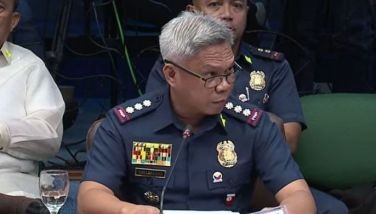Phivolcs: Metro Manila areas prone to liquefaction

MANILA, Philippines — Some areas in Metro Manila are prone to liquefaction or the loosening of waterlogged soil underground, blamed largely for the tilting or collapse of many buildings in Dagupan City in Pangasinan during the killer earthquake in July 1990.
Science Undersecretary and Philippine Institute of Volcanology and Seismology (Phivolcs) director Renato Solidum Jr. issued the warning to explain what may have caused the Emilio Aguinaldo College (EAC) building in Manila to move and lean toward an adjacent building during the magnitude 6.1 earthquake last Monday.
The 1990 Luzon earthquake killed over 1,600 people, mostly in Baguio City, Pangasinan and Nueva Ecija.
Phivolcs defines liquefaction as “a phenomenon, when loosely consolidated sediment soil deposits lose their strength and appear to flow as fluids.”
Solidum, a geologist, confirmed that the area of EAC – located on San Marcelino Street in Ermita – is prone to liquefaction.
The official, however, was uncertain whether liquefaction really triggered the tilting of the building.
He said liquefaction could be triggered by an intensity 7 quake. Manila, he said, felt the tremor last Monday at intensity 5.
There were no other reported signs of liquefaction such as cracks on the roads and water and sand shooting upward from crevasses on the ground, he added.
“Definitely, (the EAC area) is prone to liquefaction, but it (tilting of the building) could also be due to (poor) foundation and design of the building,” Solidum told The STAR.
He said liquefaction could be addressed with proper design of the edifice.
Public Works Secretary Mark Villar has asked school officials not to utilize the building anymore.
The earthquake came at a time when Manila and Pasay were preparing for massive reclamation projects in Manila Bay.
These projects include Horizon Manila, the New Manila Bay International Community, the Solar City urban center and the expansion of the Manila Harbour Center in Tondo.
Fisherfolk and environmental groups are strongly protesting the Manila Bay reclamation projects, saying these will result in severe flooding if they push through.
In an article published in The STAR in 2013, Filipino-American geologist Kelvin Rodolfo said it might not need even a strong earthquake to cause serious damage to or destroy reclaimed areas in Manila Bay.
He said in 1968, a magnitude 7.3 earthquake in Casiguran, Quezon destroyed many structures built on river deposits near the mouth of the Pasig River. The six-story Ruby Tower in Binondo collapsed, killing 260 people. He said Casiguran was 225 kilometers away from Manila.
Disaster officials, meanwhile, reported earthquake damage in Muntinlupa and Pasay.
Cupang Bridge, which also traverses Baybayin Road, had “tilting column piers” and “buckled column piers,” according to the initial damage assessment report prepared by the Muntinlupa Disaster Risk Reduction and Management Council (MDRRMO) last Tuesday.
Cracks between three and six inches wide were also found on the façade of Barangay Sucat hall. Cracks were also detected on the walls of smaller buildings nearby.
The façade of the Pasay City General Hospital also sustained some damage, according to Salvador Villarin III, head for operations of the city government’s engineering office. – With Ghio Ong
- Latest
- Trending






























